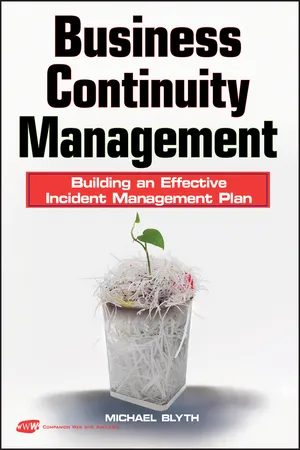
Business Continuity Management
Building an Effective Incident Management Plan
- English
- ePUB (mobile friendly)
- Available on iOS & Android
About This Book
PRAISE FOR Business Continuity Management
Few businesses can afford to shut down for an extended period of time, regardless of the cause. If the past few years have taught us anything, it's that disaster can strike in any shape, at any time. Be prepared with the time-tested strategies in Business Continuity Management: Building an Effective Incident Management Plan and protect your employees while ensuring your company survives the unimaginable.
Written by Michael Blyth—one of the world's foremost consultants in the field of business contingency management—this book provides cost-conscious executives with a structured, sustainable, and time-tested blueprint toward developing an individualized strategic business continuity program. This timely book urges security managers, HR directors, program managers, and CEOs to manage nonfinancial crises to protect your company and its employees. Discussions include:
- Incident management versus crisis response
- Crisis management structures
- Crisis flows and organizational responses
- Leveraging internal and external resources
- Effective crisis communications
- Clear decision-making authorities
- Trigger plans and alert states
- Training and resources
- Designing and structuring policies and plans
- Monitoring crisis management programs
- Stages of disasters
- Emergency preparedness
- Emergency situation management
- Crisis Leadership
- Over 40 different crisis scenarios
Developing and utilizing a business continuity plan protects your company, its personnel, facilities, materials, and activities from the broad spectrum of risks that face businesses and government agencies on a daily basis, whether at home or internationally. Business Continuity Management presents concepts that can be applied in part, or full, to your business, regardless of its size or number of employees. The comprehensive spectrum of useful concepts, approaches and systems, as well as specific management guidelines and report templates for over forty risk types, will enable you to develop and sustain a continuity management plan essential to compete, win, and safely operate within the complex and fluid global marketplace.
Frequently asked questions
Chapter 1
Business Continuity Management Plan
Business Continuity Planning Terms
- Contingency planning and crisis management
- Enterprise resilience
- Emergency preparedness
- Enterprise risk management
- Emergency management
- Critical situations management
- Governance. The loss of governmental control and policing authority can be swift and widespread. Government offices may be directly affected or overwhelmed by a crisis event, and officials may not have the knowledge, capacity, or resources to quickly support the affected populace. Government offices dedicated to dealing with a crisis situation may also be undermined as personnel respond to personal emergencies or to care for families, diminishing a government's expected capacity to respond to a crisis effectively.
- Social Fabrics. The social norms that regulate our societies can be quickly lost or undermined as the effectiveness of governance is diminished. Rioting, thefts, looting, and other social crimes can quickly spread to otherwise law-abiding sections of the community. This is a cyclic effect and can create a further loss of governance which might exacerbate a crisis and add additional elements of risk to the original crisis event.
- Utilities. Common utilities and services can be disrupted, such as power, water, sewage, and communications, during a crisis. Basic amenities like food availability, financial services, and fuel provisions can also be affected. Modern cultures are not best engineered to weather a loss of power or disruptions to food, fuel supplies, or utilities, and often struggle to manage if common services are disrupted, and such losses can also result in secondary crisis events.
- Movement. Movement can be affected by crisis situations, whether due to man-made risks presented by hostile or disruptive groups, or due to damaged infrastructures or the unavailability of fuel or power supplies. This can affect every aspect of emergency management, from those dealing with emergencies at the point of crisis to those attempting to respond in support of the emergency or evacuate from an affected area.
- Critical Services. Critical services, such as fire response, medical provisions, and health care, or critical infrastructure power and utilities can be seriously undermined with the loss of basic utilities, undermining the ability for such groups to respond to or support an affected population. Infrastructure damage and affected supply chains of critical materials or resources can quickly devalue otherwise effective critical service providers.
- Communications. Communication mediums may be affected by a crisis event disrupting or preventing the effective passage of information and instructions which might support an understanding of the crisis event, as well as the effective response to an emergency. Communication systems may be damaged, or overwhelmed by a surge of use. Often voice mediums are lost before text and this can affect both government entities' ability to mobilize and respond to a crisis, as well as a commercial organization's respond measures.
Crisis Definitions
Crisis Management
Table of contents
- Cover
- Contents
- More Praise for Business Continuity Management
- Title page
- Copyright
- Dedication
- Preface
- About the Web Site
- Chapter 1: Business Continuity Management Plan
- Chapter 2: Incident Management Plan
- Chapter 3: Crisis Management Structures
- Chapter 4: Scope of Risk
- Chapter 5: Incident Response Guidelines
- Chapter 6: Crisis Information Capture Reports
- Acknowledgments
- Index
- End User License Agreement